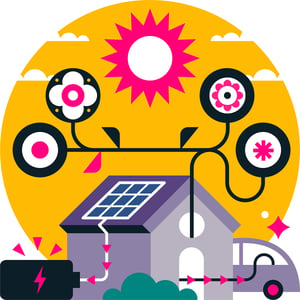Is solar right for me?
Solar power can work for more types of homes and lifestyles than people might imagine.
With the current cost of electricity, the payback on a solar installation is now 30% quicker than it was even last year. And as technologies evolve and more and more people buy electric cars, now may be the time to reconsider whether solar is right for you.
Loop's Solar and Battery Simulator takes the risk out of solar and battery installations by simulating the impact of different types of systems before you install them. If you've got a smart meter you can try this out for free.
Are Solar Panels Right for You?
Whether you're curious about the benefits of solar energy, want to understand the installation process, or are eager to learn about the latest innovations in the solar industry, we've got you covered. Our newsletter is packed with expert insights, helpful tips, and answers to all your burning questions about solar power.
The right type of home
To get the most out of solar panels, ideally you would live in a house with an unshaded, south-facing roof, which is angled between 30 and 50 degrees from horizontal.
The average domestic solar system is 4 kWp (kWp, or kilowatt peak, is the terminology used to describe the peak output of a solar system or panel) which, on a home in the south of England, can generate around 4,200 kilowatt hours of electricity a year. The problem is that whilst this is theoretically more than enough to cover the energy needs of an average house, it's not quite as simple as that. Unless you use the solar energy when it's made, it's exported to the grid. More on that later.
Of course, not everyone is so lucky as to have the perfect position for solar panels on their home. But that’s not to say you can’t still successfully harness the power of the sun: one firm in the sector, Moixa, says that even on north, east or west-facing roofs you’ll only lose around 15% compared to a south-facing option.
You may even be able to make up for that difference. Increasingly, solar panel installers are helping homeowners with roofs that aren’t ideal - perhaps because they’re not facing south or are partly shaded - to generate the same amount of power as those ideally-placed south-facing roofs.

Solar technology firm SolarEdge, for example, says that larger arrays of panels are becoming more popular as a way of enabling people with roofs that don’t appear ideal to still generate decent yields; by adding more panels on roofs facing east or west, households may manage to match yields of smaller arrays on south facing roofs.
Improving technologies are also helping here. This includes the use of microinverters and power optimizers to improve performance for solar panels on complicated roofs, or roofs that experience marginal shading during the day.
What about flat roofs? It can be a little more complicated to have solar systems fitted on a flat roof than a pitched roof - for example because flat roof systems take up more space per kW than sloping roof systems - but it is still entirely possible.
So, if your home doesn’t appear right for solar at first glance, don’t write it off. Speak to solar system installers and find out what can be done in your individual circumstances.
Storing
Solar panels don’t generate energy at night-time, nor do they store the energy they generate to use when the sun isn’t shining. Surplus energy that you don’t use is ‘exported’ to the local electricity grid (which you could get paid for under the Smart Export Guarantee). And when the panels aren’t generating enough energy for your needs, you need to buy electricity from your supplier.
So, you may wonder whether they would suit you and your energy needs, particularly if your lifestyle means you tend to use more electricity at night, and perhaps very little during the day.
But thankfully there is an answer: a home battery. This would enable you to really make the most of your solar panels, by storing the energy to use later in the day. A battery can help you cut the amount of electricity you need to buy from the grid, saving you money on your bill.
Most batteries enable you to track your energy use online and decide when to charge your storage unit and when you need to draw on that power.
They can also be charged overnight when grid electricity is cheaper, for example if you have a time of use or agile tariff.
A lifestyle choice
For many people, home energy means nothing more than bills and paperwork.
But once you start generating your own energy, that can all change, as you become more self-sufficient. Easy behaviour changes can make a big difference to how much value you get from your solar installation. Put simply, if you don't have a home battery, the more of your solar power you use, the less you need to buy from the grid later. So by making sure you are doing your washing, running the dishwasher, using your electric oven and even heating your hot water whilst your solar is generating you are avoiding having to pay for these with expensive grid energy. NB: it's a balancing act though as if you do too many energy-intensive things at once, you may be using more than your solar installation is able to generate, meaning you end up using costly grid energy anyway. A solar generation meter and your smart meter's in-home display will allow you check you're not using more than you're producing.
If you go a step further and buy an electric car then energy generation becomes intricately entwined with your lifestyle. This is because electric vehicles (EVs) and home solar generation go hand-in-hand. If you have an electric car, charging it at home is most likely to be your cheapest and most convenient option.

If you’re on an off-peak overnight electricity tariff, charging your car at night at a lower rate makes a lot of sense. That could work both ways too; ‘Vehicle to Grid’ systems are being trialled which automatically charge your car when demand on the grid is low, and then sell the energy back to the grid when demand is high. So, you save money, and also help to reduce pressure on the grid.
As more and more people buy electric cars - ahead of a ban on the sale of new diesel and petrol cars in the UK in 2030 - their owners, who may have never even considered solar, will suddenly have good reason to do so.
Is solar right for my wallet?
Fitting solar panels will save money on your energy bills, as you won’t have to buy as much – if any – energy from the grid.
Also, there are incentives available to help make it work for you financially. The Smart Export Guarantee, or SEG, is a way of getting paid for the excess electricity you generate from solar panels. It doesn’t provide as strong a financial incentive as the old Feed in Tariff (FIT scheme), as SEG only pays for excess electricity exported to the grid, while FIT paid people for all of the electricity that they generated.
That said, the savings from solar PV with the SEG are much greater than they would be otherwise - an even more with energy prices skyrocketing. The Energy Saving Trust has some useful charts showing different cost savings in different scenarios - scroll down towards the bottom of this page to see them.
• • •
With so many moving parts to consider - roof slope, orientation, patterns of usage. system size and type in particular - evaluating whether solar and perhaps a home battery would work for you is no easy task. There are basic calculators available but these use estimates and provide only a basic level of insight.
Loop's Solar and Battery Simulator takes the risk out of solar and battery installations by simulating the impact of different types of systems before you install them, using details about your own house, your own patterns of energy usage and solar yield based on actual weather data. You are also able to see the impact of fitting different capacities of home battery to assess whether that makes solar work for you.
Considering solar? Got a smart meter? Sign up for Loop for free below and find out exactly what difference solar could make to your energy bill.
• • •
Subscribe to our solar newsletter for expert guidance on all things solar power. If you want to learn more about the installation process, costs, savings and more - we’ve got you covered!









